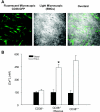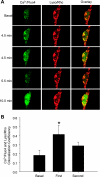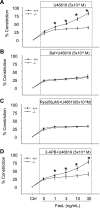Lysosome-dependent Ca(2+) release response to Fas activation in coronary arterial myocytes through NAADP: evidence from CD38 gene knockouts
- PMID: 20200208
- PMCID: PMC2867387
- DOI: 10.1152/ajpcell.00533.2009
Lysosome-dependent Ca(2+) release response to Fas activation in coronary arterial myocytes through NAADP: evidence from CD38 gene knockouts
Abstract
Activation of the death receptor Fas has been implicated in the development of vascular injury or disease, but most studies have focused on its role in the regulation of cell apoptosis and growth. The present study was designed to examine the early response of coronary artery to Fas activation by its ligand, FasL. The hypothesis being tested is that CD38 signaling pathway mediates FasL-induced intracellular Ca(2+) release through nicotinic acid adenine dinucleotide phosphate (NAADP) in mouse coronary arterial myocytes (CAMs) and thereby produces vasoconstriction in coronary arteries. HPLC analysis demonstrated that FasL markedly increased NAADP production in CAMs from wild-type mice (CD38(+/+)) but not in cells from CD38 knockout (CD38(-/-)) mice. Using fluorescent Ca(2+) imaging analysis, we found that FasL (10 ng/ml) significantly increased Ca(2+) release from 142.5 +/- 22.5 nM at the basal level to 509.4 +/- 64.3 nM in CD38(+/+) CAMs but not in CD38(-/-) CAMs. However, direct delivery of NAADP, the CD38 metabolite, into CD38(-/-) CAMs still markedly increased Ca(2+) release, which could be significantly attenuated by a lysosomal function inhibitor, bafilomycin A1 (Baf), or a NAADP antagonist, pyridoxalphosphate-6-azophenyl-2-disulfonic acid. Confocal microscopy further demonstrated that FasL produced a typical two-phase Ca(2+) release with a local Ca(2+) burst from lysosomes, followed by a global Ca(2+) response in CD38(+/+) CAMs. In isolated perfused septal coronary arteries from CD38(+/+) mice, FasL was found to significantly increase U-46619-induced vasoconstriction from 29.2 +/- 7.3 to 63.2 +/- 10.3%, which was abolished by Baf (100 nM). These results strongly indicate that the early response of CAMs to FasL is to increase intracellular Ca(2+) levels and enhance the vascular reactivity through stimulation of NAADP production and lysosome-associated two-phase Ca(2+) release in coronary arteries.
Figures







Similar articles
-
NAD(P)H oxidase-dependent intracellular and extracellular O2•- production in coronary arterial myocytes from CD38 knockout mice.Free Radic Biol Med. 2012 Jan 15;52(2):357-65. doi: 10.1016/j.freeradbiomed.2011.10.485. Epub 2011 Nov 3. Free Radic Biol Med. 2012. PMID: 22100343 Free PMC article.
-
CD38 mediates angiotensin II-induced intracellular Ca(2+) release in rat pulmonary arterial smooth muscle cells.Am J Respir Cell Mol Biol. 2015 Mar;52(3):332-41. doi: 10.1165/rcmb.2014-0141OC. Am J Respir Cell Mol Biol. 2015. PMID: 25078456 Free PMC article.
-
Intracellular two-phase Ca2+ release and apoptosis controlled by TRP-ML1 channel activity in coronary arterial myocytes.Am J Physiol Cell Physiol. 2013 Mar 1;304(5):C458-66. doi: 10.1152/ajpcell.00342.2012. Epub 2013 Jan 2. Am J Physiol Cell Physiol. 2013. PMID: 23283937 Free PMC article.
-
Resolving the topological enigma in Ca2+ signaling by cyclic ADP-ribose and NAADP.J Biol Chem. 2019 Dec 27;294(52):19831-19843. doi: 10.1074/jbc.REV119.009635. Epub 2019 Oct 31. J Biol Chem. 2019. PMID: 31672920 Free PMC article. Review.
-
The calcium signaling enzyme CD38 - a paradigm for membrane topology defining distinct protein functions.Cell Calcium. 2022 Jan;101:102514. doi: 10.1016/j.ceca.2021.102514. Epub 2021 Dec 1. Cell Calcium. 2022. PMID: 34896700 Review.
Cited by
-
Acidic NAADP-sensitive calcium stores in the endothelium: agonist-specific recruitment and role in regulating blood pressure.J Biol Chem. 2010 Nov 26;285(48):37133-7. doi: 10.1074/jbc.C110.169763. Epub 2010 Sep 27. J Biol Chem. 2010. PMID: 20876534 Free PMC article.
-
Preferential Coupling of the NAADP Pathway to Exocytosis in T-Cells.Messenger (Los Angel). 2015 Jun;4(1):53-66. doi: 10.1166/msr.2015.1040. Messenger (Los Angel). 2015. PMID: 27330870 Free PMC article.
-
Concentration-Dependent Diversifcation Effects of Free Cholesterol Loading on Macrophage Viability and Polarization.Cell Physiol Biochem. 2015;37(2):419-431. doi: 10.1159/000430365. Epub 2015 Aug 28. Cell Physiol Biochem. 2015. PMID: 26314949 Free PMC article.
-
Regulation of TRPML1 channel activity and inflammatory exosome release by endogenously produced reactive oxygen species in mouse podocytes.Redox Biol. 2021 Jul;43:102013. doi: 10.1016/j.redox.2021.102013. Epub 2021 May 16. Redox Biol. 2021. PMID: 34030116 Free PMC article.
-
NAADP receptors.Cold Spring Harb Perspect Biol. 2011 Jan 1;3(1):a004036. doi: 10.1101/cshperspect.a004036. Cold Spring Harb Perspect Biol. 2011. PMID: 21047915 Free PMC article. Review.
References
-
- Aarhus R, Graeff RM, Dickey DM, Walseth TF, Lee HC. ADP-ribosyl cyclase and CD38 catalyze the synthesis of a calcium-mobilizing metabolite from NADP. J Biol Chem 270: 30327–30333, 1995 - PubMed
-
- Andrews NW. Regulated secretion of conventional lysosomes. Trends Cell Biol 10: 316–321, 2000 - PubMed
-
- Boittin FX, Galione A, Evans AM. Nicotinic acid adenine dinucleotide phosphate mediates Ca2+ signals and contraction in arterial smooth muscle via a two-pool mechanism. Circ Res 91: 1168–1175, 2002 - PubMed
Publication types
MeSH terms
Substances
Grants and funding
LinkOut - more resources
Full Text Sources
Other Literature Sources
Molecular Biology Databases
Research Materials
Miscellaneous

